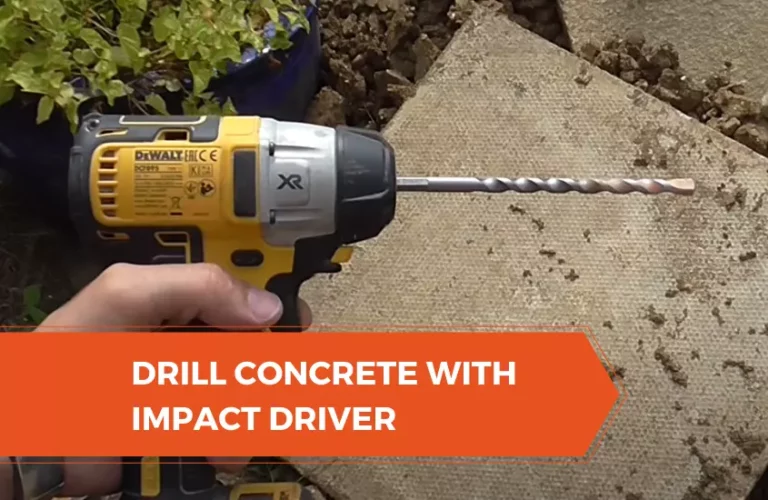
How to Drill Holes in Concrete with an Impact Driver: 5 Easy-Peasy Steps
If you have experience drilling into concrete, you better know about it. Drilling holes in concrete is difficult, especially if you don’t have the right tools. This process can be challenging because the concrete may break and cause the hole to get bigger or smaller than usual.
Stop scratching your head; I’ve got you covered! It would help if you didn’t forget about the versatility of an impact driver, which can do almost everything. But can you drill into concrete with an impact driver?
Well, this is what I’m going to talk about today. Following the five basic methods can be done without even taking experts’ assistance. So let’s get deeper to learn all the nooks and crannies right away!
Can I Use Impact Driver on Concrete?
An impact driver, also known as a hammer driver, can be used on concrete floors and walls. But it is not recommended for use on asphalt or cement paving. Before using an impact driver on concrete, you should test it out on a scrap piece of hammer driver and a regular driver both spin to create holes, but they work in different ways.
How to Drill Holes in Concrete with an Impact Driver: 5 Easy-Peasy Steps
Step-1:
The best place to start is with the concrete itself. Find the lowest point on the concrete and drill a pilot hole there.
Step-2:
The deeper you go, the stronger the anchor will be. Add another half-inch to your hole for every layer of concrete you go through.
Step-3:
So if you’re drilling a quarter-inch into the top layer of concrete, make it 3/8″ deep into the ground underneath it.
Step-4:
Then you have to push your screw into that hole. Now it’s time to put in your screws! Make sure they’re tightened down by hand, then use pliers to get them as tight as possible. That’s the least you can do.
Step-5:
Finally, it is time to get a meter and verify the concrete. You want to see at least 6 pounds of torque pushing on that screw.
If you follow these steps, then as long as your screw holes are straight, dry, and have good soil around them: you’re pretty much good to go!
Can You Drill into Brick with an Impact Driver?
Modern brick homes tend to be less capable of holding screws. They don’t have the pilot holes; you need to drill with a screwdriver-type drill/driver. The impact driver locks onto the head of the screw and then uses a rapid tapping to generate rotational momentum. Once I had mastered using it properly, I never had another problem with these drills/drivers!
Drilling Holes in Concrete with Impact Driver – Is It Safe?
It is not safe in every situation to drill through a concrete column. It will weaken the structure. This method applies to interior and exterior columns on new or old buildings.
However, it is possible to attach something to an exterior column. Suppose you put it in between two reinforcing forms after pouring concrete. Be sure to patch the holes to prevent water from damaging the bare concrete.
Will My Drill Work On Concrete?
A regular drill will not work on concrete. If you want to drill through concrete, you need to use an impact hammer drill. Even with an impact hammer type of drill, it can be difficult because all that hammering can make the bit get stuck in the concrete and break it off. To improve your chances of making a hole in the concrete, you need to start with a carbide steel drill bit.
Which Drill Machine Is Best For Concrete?
Depending on the job you’re planning to do, there are two main types of drill machines suitable for working with concrete: hammer drills and impact drivers.
Hammer drills deliver a rotating movement transmitted into a pounding motion thanks to an internal mechanism. Impact drivers, on the other hand, offer fast and powerful rotations that are transmitted into the material through sheer kinetic energy.
Why Should You Drill Into Concrete?
Drilling into concrete is an excellent way to add new hooks, shelves, and other hardware. There are plenty of reasons to drill into concrete; here are they:
- To find water, fuel lines, and electrical circuits that may have become disconnected and hidden over time.
- To create more minor pathways for new pipes or wires.
- To assist with excavation of buried structures or deep foundations.
- To avoid potential interference with existing, hidden infrastructure. And drills are often the best tool for preventing costly damages.
Wrapping Up
So if anybody asks – “can you drill into concrete with an impact driver,” show them what you’ve learned through this single write-up! When using an impact driver to drill holes in concrete, it is vital to make sure that you have aligned the bit correctly with the workpiece. This article will ensure that you don’t cause any damage to the material when you start drilling.
